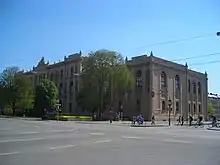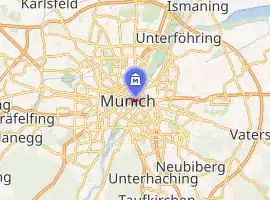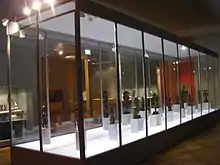Museum Five Continents
The Museum Five Continents or Five Continents Museum (German: Museum Fünf Kontinente) in Munich, Germany is a museum for non-European artworks and objects of cultural value. Its name until 9 September 2014 was Bavarian State Museum of Ethnology (German: Staatliches Museum für Völkerkunde).
Museum Fünf Kontinente | |
_2020.JPG.webp) | |
 | |

| |
| Established | 1868 |
|---|---|
| Location | Munich, |
| Type | Ethnographic museum |
| Executive director | Uta Werlich[1] |
| Owner | Bayerisches Staatsministerium für Wissenschaft und Kunst |
| Website | www |
The building



The building in Munich's Maximilianstrasse, one of the city's four royal avenues, was originally constructed in 1859-1865 for the Bavarian National Museum by Eduard Riedel adverse to the building of the Government of Upper Bavaria. The architecture is influenced by the Perpendicular Style.
The collections
The collection was founded in 1868, but its history started much earlier. The first collectors of objects from outside Europe were the members of the Wittelsbach dynasty. Today the museum is the second largest in Germany, outnumbered only by Berlin, with a collection of 200.000 objects and an exhibition area of 4,500 square meters.
The total area is about 12,000 m² and includes also facilities for carpentry, metalworking, painting and restoration, magazines, a meeting- and conference-room and offices.
On the second floor the permanent exhibitions for Art and Culture of the Americas and of Africa are shown while the exhibitions about the Islamic World, India, East Asia and Oceania are located in the first floor.
- North America
Indian teepee, the world's oldest surviving kayak (1577), Masks of the Northwest Coast Indians, wooden bird masks, decorated moccasins and other textiles
- South America
Ceramics and objects of gold, silver and wood, as well as the art of the Inca Indians of Mexico, gods and war figures, masks, jewelry, vessels and textiles from Peru and Bolivia, everyday objects of the Indians of the Amazon, head trophies from Brazil
- Africa
Plastic arts with masks and figures from all parts of Africa, for example, Religious figure "Nduda" from Yombe / Zaire (19th century), sculptures and weapons from West Africa, silver handicrafts from Ethiopia, body jewelry from South Africa, ivories and bronzes from Guinea
- Islamic Arts and Cultures
Islamic works of art (7th to 20th century): religious objects; Islamic popular culture between the 18th and 20th Century as well as modern Islamic art
- South Asia
Colourful Indian deities, E.G. Nandi statue from India, Kapardin fragment of the Buddha (2nd century AD), Buddha heads of sandstone, statues of Shiva and Krishna
- East Asia
Chinese wood sculptures, sitting on the world throne Buddha Amitabha, ivory model of a pagoda from the Chinese emperor, Ornate carvings from China, Japan and Indonesia
- Oceania
Polynesian bar deity (Cook Islands), Melanesian paddle showing a fishing scene, Malangan figure from Melanesia, Arms and shields from Australia
Return of remains to Australia
In April 2019, work began to return more than 50 ancestral remains from five different German institutes, starting with a ceremony at the Five Continents Museum. The remains of a Gimuy Walubara Yidindji king were handed to representatives from the Yidindji nation, who are located around modern-day Cairns in northern Queensland. The remains had been in German possession since 1889.[2]
References
- Dr. Uta Werlich ist neue Leiterin des Museums Fünf Kontinente
- Hirini, Rangi (10 April 2019). "Germany returns Aboriginal ancestral remains in largest hand back". SBS. NITV. Retrieved 5 May 2019.